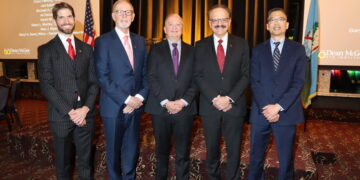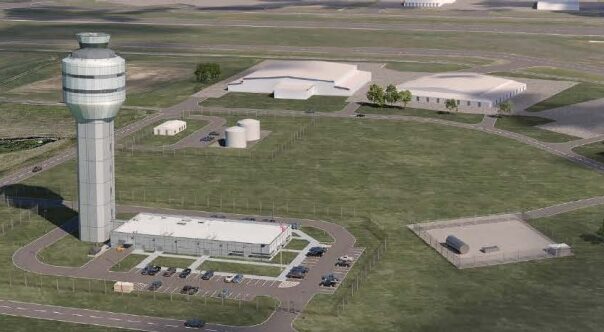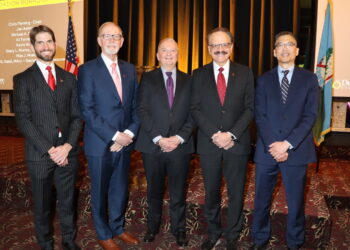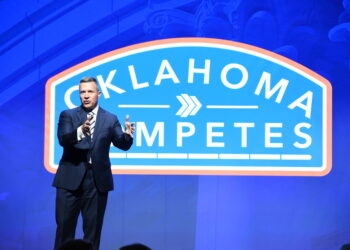TULSA, Okla. (OBV) – Ground was broken at Tulsa International Airport on a new air traffic control tower complex that will honor the late James Inhofe, a U.S. senator who championed aviation in Oklahoma.
The groundbreaking of the Senator James M. Inhofe Air Traffic Control Tower Complex was held earlier this month.
The new tower will replace the current air traffic control tower and base building, which opened in 1961. It is one of the oldest towers within the FAA’s air traffic organization, according to Oklahoma Aerospace & Aeronautics officials.
“I am thrilled to that Tulsa International Airport is getting a new, state of the art air traffic control tower,” said Lt. Gov. Matt Pinnell. “Oklahoma has a legacy of aerospace innovation and success dating back over a century, and this project will play an important role in ensuring passenger safety and promoting economic growth for years to come. Aerospace is Oklahoma’s fastest growing industry, and I’m thankful that the Oklahoma legislature and others see its value and make it a priority.”
The current tower has received modifications to accommodate evolving operational and technological needs over the past 63 year, but the structure falls short of present-day building code. Its maintenance needs have climbed and change is needed to ensure the safety, security, and continuity of the state’s air transportation system, according to aerospace officials.
“After years of fundraising and planning, we are thrilled that construction will begin soon on this highly anticipated project,” said Alexis Higgins, Chief Executive Officer at Tulsa Airports Improvement Trust. “The new tower complex is more than an upgrade; it’s a commitment to safety, efficiency, and the future of air travel at our airport and throughout the region.”
The new tower is projected to cost $112,612,600 and be completed by Spring 2027. Construction begins this September. It will stand 257 feet, more than 100 taller than the current tower. The increased height will provide greater visibility and enable the airport to develop additional property on its land, according to aerospace officials.

A combination of city, county, state and federal funds will cover the tower’s creation.
“I am grateful for the support of every level of government in making our new air traffic control tower possible: federal, state, county, and city,” Tulsa Mayor G.T. Bynum said. “To break ground on this new tower secures our future as a regional aviation hub and sends an important message to the aerospace industry that Tulsa is open for business.”
A breakdown of the new tower’s timeline, costs, and funding is as follows:
Project Timeline:
- Construction September 2024 – October 2026
- FAA Equipment Installation – Winter 2026
- Acceptance and Operational Start – Spring 2027
Estimated Project Costs
- Engineering Design: $4,615,402
- Construction and Project Administration: $81,514,000
- FAA Equipment and Services: $26,483,198
- Total Projected Cost: $112,612,600
Grant Funding Sources
- Tulsa County: $7,000,000
- City of Tulsa: $7,000,000*
- State of Oklahoma: $19,600,000
- Federal Appropriation: $40,000,000
- FAA Bipartisan Infrastructure ATP: $12,500,000
Total Grant Funds: $86,100,000
Inhofe died at age 89 in July. He championed of Oklahoma’s aviation and the aerospace industry.
“It’s great to see the construction of this much-needed control tower at Tulsa International Airport finally commence. This project will further enhance the efficiency of this great airport”, said State Sen. John Haste, R-Broken Arrow. “While I deeply regret that Senator Inhofe is not here to witness this momentous occasion, I am grateful to see this dedication to his enduring legacy. His tireless efforts on behalf of Oklahoma will be felt for decades to come.”
The State Chamber of Oklahoma honored Inhofe’s many contributions to aviation in 2022 by helping establish the Senator James M. Inhofe FAA Knowledge Test Scholarship. The award helps cover testing fees for Oklahoma high school students who are enrolled in the AOPA Foundation’s “You Can Fly” STEM curriculum.
“My hope is that his passion for flying is going to help kids take that first step to getting their pilot’s license and achieve a good career in aviation,” said Chad Warmington, president and CEO of The State Chamber, said at the time. “It’s a perfect, symbolic testament of what he meant to Oklahoma and aviation. Sen. Inhofe’s legacy will lead to a whole new generation of kids involved in aerospace.”
Inhofe served in the Oklahoma Legislature, was mayor of Tulsa, served in the U.S. House of Representatives from 1987 to 1995 and the U.S. Senate from 1994 to 2023.
“I’m very grateful and humbled to be the namesake of the Senator James M. Inhofe FAA Knowledge Test Scholarship,” Inhofe said in 2022. “This scholarship is a testament to my priorities as a pilot—ensuring the next generation of pilots have the resources they need to take to the skies. It has been an honor to have been a voice for pilots in Washington while working with AOPA to address the needs of pilots and the entire general aviation community. From the Pilots Bill of Rights 1 and 2 and the Volunteer Pilot Protection Act, and fighting against the privatization of air traffic control while fighting for aviation workforce development, we have gotten a lot done helping young people reach their dreams of becoming a pilot.”
Inhofe previously told the Oklahoma Historical Society that he was fascinated with aviation as a young man; he often visited airports to see planes take flight. He earned his pilot’s license at age 28. His fascination became an enduring passion, and he has flown his aircraft across the world. As a U.S. Senator, Inhofe championed the rights of pilots. He introduced both the Hoover Bill in 1999 and the Pilot’s Bill of Rights in 2011.
The Hoover Bill enabled FAA certificate holders to appeal an emergency revocation’s immediate nature to the National Transportation Safety Board (NTSB). The Pilot’s Bill of Rights ensured greater fairness in FAA enforcement proceedings and NTSB reviews, giving pilots greater access to information needed to defend themselves during enforcement proceedings. Both pieces of legislation were signed into law.

















